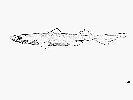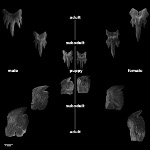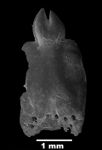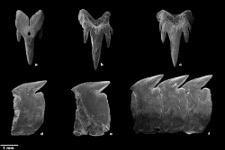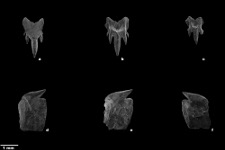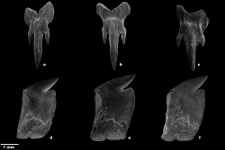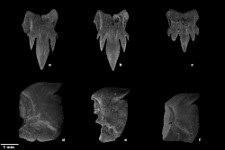Etmopterus granulosus
(Günther, 1880)
Southern lanternshark
Classification: Elasmobranchii Squaliformes Etmopteridae
Reference of the original description
Report on the shore fishes procured during the voyage of H. M. S. Challenger in the years 1873-1876. Zoology, 1(6), 1–82
Report on the shore fishes procured during the voyage of H. M. S. Challenger in the years 1873-1876. Zoology, 1(6), 1–82
Image of the original description
.jpg)
Etmopterus granulosus (Günther, 1880)
.jpg)
Etmopterus granulosus (Günther, 1880)
Synonyms / new combinations and misspellings
Centroscyllium granulosum, Centroscyllium granulosus, Etmopterus baxteri, Etmopterus cf. granulosus, Etmopterus tasmaniensis, Spinax granulosus
Centroscyllium granulosum, Centroscyllium granulosus, Etmopterus baxteri, Etmopterus cf. granulosus, Etmopterus tasmaniensis, Spinax granulosus
Types
Etmopterus granulosus
Holotype: BMNH: 1879.5.14.460
Etmopterus baxteri
Holotype: NMNZ: P01950;
Etmopterus tasmaniensis
XXXX: No types known;
Etmopterus granulosus
Holotype: BMNH: 1879.5.14.460
Etmopterus baxteri
Holotype: NMNZ: P01950;
Etmopterus tasmaniensis
XXXX: No types known;
Description :
Citation: Etmopterus granulosus (Günther, 1880): In: Database of modern sharks, rays and chimaeras, www.shark-references.com, World Wide Web electronic publication, Version 01/2026
Please send your images of "Etmopterus granulosus" to info@shark-references.com

Etmopterus granulosus (Günther, 1880), Chile © Dr. Nicolas Straube, Curator of Ichthyology & Associate Professor, Department of Natural History, University Museum of Bergen

Etmopterus granulosus (Günther, 1880), Chile © Dr. Nicolas Straube, Curator of Ichthyology & Associate Professor, Department of Natural History, University Museum of Bergen
Common names
 Tollo lucero,
Tollo lucero,  Tollo negro narigón,
Tollo negro narigón,  Sagre long nez,
Sagre long nez,  Sagre longnez,
Sagre longnez,  Sagre porte-feu,
Sagre porte-feu,  Black shark,
Black shark,  Lucifer,
Lucifer,  New Zealand lanternshark,
New Zealand lanternshark,  Seal shark,
Seal shark,  Southern lantern shark,
Southern lantern shark,  Southern lanternshark,
Southern lanternshark,  Southern laternshark,
Southern laternshark,  Stout deepsea shark
Stout deepsea shark
 Tollo lucero,
Tollo lucero,  Tollo negro narigón,
Tollo negro narigón,  Sagre long nez,
Sagre long nez,  Sagre longnez,
Sagre longnez,  Sagre porte-feu,
Sagre porte-feu,  Black shark,
Black shark,  Lucifer,
Lucifer,  New Zealand lanternshark,
New Zealand lanternshark,  Seal shark,
Seal shark,  Southern lantern shark,
Southern lantern shark,  Southern lanternshark,
Southern lanternshark,  Southern laternshark,
Southern laternshark,  Stout deepsea shark
Stout deepsea shark
Short Description
A large, heavy-bodied lanternshark with a big head [536], bladelike unicuspidate teeth in lower jaw and teeth with cusps and cusplets in upper jaw, stocky body, conspicuous lines of denticles on body, conspicuous black markings on underside of body and tail, with tail marking short and not extending far posteriorly [518]. Dark brown or black in color, possibly darker below [578].
A large, heavy-bodied lanternshark with a big head [536], bladelike unicuspidate teeth in lower jaw and teeth with cusps and cusplets in upper jaw, stocky body, conspicuous lines of denticles on body, conspicuous black markings on underside of body and tail, with tail marking short and not extending far posteriorly [518]. Dark brown or black in color, possibly darker below [578].
Distribution
Southeast Pacific: Chile, Southwest Pacific: Australia, New Zealand; Southwest Atlantic: southern Chile, southern Argentina, the Falkland Islands; Southeast Atlantic: South Africa; Indian Ocean, Southern Madagascar Ridge & Amsterdam Island Source: www.gbif.org
Southeast Pacific: Chile, Southwest Pacific: Australia, New Zealand; Southwest Atlantic: southern Chile, southern Argentina, the Falkland Islands; Southeast Atlantic: South Africa; Indian Ocean, Southern Madagascar Ridge & Amsterdam Island Source: www.gbif.org
Human uses
fisheries: of no interest
fisheries: of no interest
Biology
Ovoviviparous, with 10-13 in a litter [1388]. Size at birth about 18 cm [1388]. Distinct pairing with embrace [17086]. Found on the continental slope (Ref. 75154).
Ovoviviparous, with 10-13 in a litter [1388]. Size at birth about 18 cm [1388]. Distinct pairing with embrace [17086]. Found on the continental slope (Ref. 75154).
Dentition
Teeth of Etmopterus baxteri (synonym of E. granulosus): Teeth 14-1-14/25-27, dissimilar in the two jaws. The upper teeth erect, each with a long, sharply-pointed, awl-shaped, smooth-edged major cusp flanked on each side by up to four small lesser cusps, and borne on a longitudinally-striated bifid base. Most of the upper teeth have three lesser cusps on each side of the major cusp, with the middle cusp of these three considerably larger than the others though not more than one-third the length of the major cusp. A few teeth near the centre of the jaw have four lesser cusps on each side, with the largest lesser cusp separated from the major cusp by two small lesser cusps, while in the teeth towards the angle of the jaw there is a reduction in the number of lesser cusps to one or two on each side. Three series of upper teeth functional at the centre of the jaw, two towards the angles. The lower teeth blade-like, each with a smooth, little-sculptured, rectangular base almost twice as high as broad, and bearing a single, smooth-edged, triangular cusp. Each cusp is sharply notched laterally, strongly oblique, and overlaps the adjacent cusp so that an almost continuous cutting edge is formed. There is no median tooth, and the base of the first tooth on the left side overlaps that of the first tooth on the right. A single series of lower teeth functional [2751];
Teeth of Etmopterus baxteri (synonym of E. granulosus): Teeth 14-1-14/25-27, dissimilar in the two jaws. The upper teeth erect, each with a long, sharply-pointed, awl-shaped, smooth-edged major cusp flanked on each side by up to four small lesser cusps, and borne on a longitudinally-striated bifid base. Most of the upper teeth have three lesser cusps on each side of the major cusp, with the middle cusp of these three considerably larger than the others though not more than one-third the length of the major cusp. A few teeth near the centre of the jaw have four lesser cusps on each side, with the largest lesser cusp separated from the major cusp by two small lesser cusps, while in the teeth towards the angle of the jaw there is a reduction in the number of lesser cusps to one or two on each side. Three series of upper teeth functional at the centre of the jaw, two towards the angles. The lower teeth blade-like, each with a smooth, little-sculptured, rectangular base almost twice as high as broad, and bearing a single, smooth-edged, triangular cusp. Each cusp is sharply notched laterally, strongly oblique, and overlaps the adjacent cusp so that an almost continuous cutting edge is formed. There is no median tooth, and the base of the first tooth on the left side overlaps that of the first tooth on the right. A single series of lower teeth functional [2751];
Remarks
shark-references Species-ID=2174; Links:
digital version of the original description of E. granulosus: GÜNTHER, A. 1880: Report on the shore fishes procured during the voyage of H. M. S. Challenger in the years 1873-1876, 1 (6): 1-82, Pls. 1-32"
digital version of the original description of E. baxteri: GARRICK, J.A.F. 1957: Studies on New Zealand Elasmobranchii. Part VI. Two new species of Etmopterus from New Zealand. Bulletin of the Museum of Comparative Zoology at Harvard College, 116 (3): 169-190"
shark-references Species-ID=2174; Links:
digital version of the original description of E. granulosus: GÜNTHER, A. 1880: Report on the shore fishes procured during the voyage of H. M. S. Challenger in the years 1873-1876, 1 (6): 1-82, Pls. 1-32"
digital version of the original description of E. baxteri: GARRICK, J.A.F. 1957: Studies on New Zealand Elasmobranchii. Part VI. Two new species of Etmopterus from New Zealand. Bulletin of the Museum of Comparative Zoology at Harvard College, 116 (3): 169-190"
Parasites (arranged by Jürgen Pollerspöck)
Monogenea
Cestoda
Trematoda
Nematoda
Copepoda
Thecostraca
Monogenea
Cestoda
- Aporhynchus sp. [26778]
- Aporhynchus tasmaniensis Beveridge, 1990 [16251] [16112]
- Gilquinia squali (Fabricius, 1794) [16182] [25154]
- Hepatoxylon sp. [26778]
- Plesiorhynchus etmopteri Beveridge, 1990 [16112]
- Plesiorhynchus sp. [26778]
Trematoda
- Otodistomum sp. [26778]
Nematoda
- Anisakis sp. [26778]
Copepoda
Thecostraca








